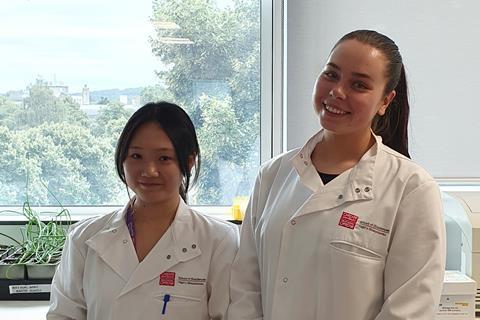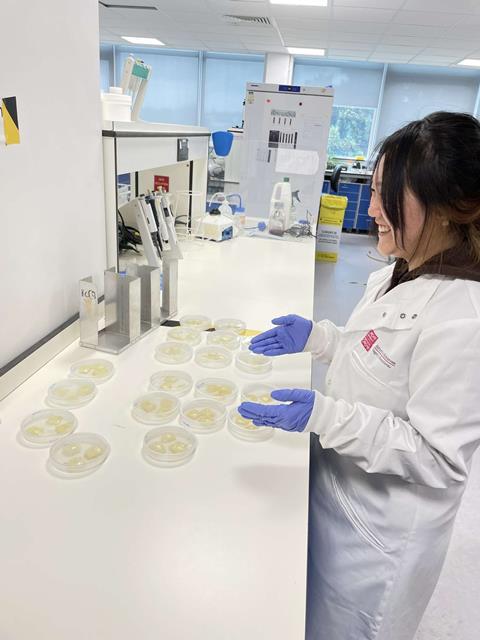Shi Yang Xie is doing a Applied Microbiology International Summer Placement at Cardiff University School of Biosciences with Dr Rebecca Weiser. She reveals what her research into bacterial onion rot is uncovering - and what it’s like to work in a laboratory.
Where are you are doing your placement and what is the subject?
My placement is at Cardiff University School of Biosciences (Sir Evans Martin Building) with Dr Rebecca Weiser
I am investigating ways to model bacterial onion rot (BOR) to help us better understand this agriculturally important crop disease. Onions have a UK Farm Gate production value of £154 million (2021) and (BOR) can cause up to £9 million in losses per annum.

A bacterial species called Burkholderia gladioli (B. gladioli) is one of the primary causes of bacterial infection, accounting for over 95% of cases. There is a lack of understanding of BOR and the mechanism of B. gladioli in onion plants causing onion rotting is unclear. This delays the development of prevention and treatment strategies for BOR, such as the use of bacteriophages.
What you personally are working on in the placement and what have you found?
The overall aim of my project is to investigate the behaviour of B. gladioli in different onion rot models using fluorescent reporter strains.
So far, I have generated fluorescent reporter strains of B. gladioli that cause different levels of onion rot by electroporation of a plasmid carrying enhanced green fluorescent protein (eGFP) into these strains. I have also tested the stability of the plasmid carriage in the eGFP-tagged strains, to determine if they are suitable for use in onion rot models.
The next steps are to optimise in vitro and or in vivo models for bacterial onion rot using onion slices, whole onion bulbs, onion seedlings and onion plants by testing conditions such as inoculum size, incubation temperature and time. I will test the reporter B. gladioli strains in the optimised in vitro onion models and visualise the distribution of the bacteria using an imager which can detect fluorescence.
Has anything surprised you?
I have been surprised that not everything worked the first time! For example, I tried to generate six fluorescently tagged B. gladioli strains and could only get three of them to work, which is a 50% success rate.
I also found that the plasmid is potentially not stably maintained in two of these strains after three days of growth. This has implications for the onion rot models as a decrease in fluorescence may mean that the strains have lost their plasmid rather than that they have stopped growing in the onions. To investigate this further, I will need to include extra checks in the rot models to correlate fluorescent intensity to a number of bacterial cells in the onion tissue.

This placement has also provided me with valuable insight into what is like working in a laboratory. One of the challenges is the preparation for the experiments, and it is crucial to understand the protocol for the experiment to make sure all the equipment and materials are ready beforehand.
This could be streaking out plates two days before or measuring out the growth curve of the bacteria to ensure another experiment can be carried out within a manageable time range.
How does your work fit in with the real-world aims of the lab’s work?
My placement supervisor is working on a project in collaboration with a biocontrol company and onion growers that investigates the development of a bacteriophage biocontrol strategy for bacterial onion rot.
The results of my project will improve our understanding of how the bacteria behave in onion plants to cause rotting, which in turn will help inform wider research on biocontrol strategies for plant disease.
What is your least favourite job in the lab?!
I am working in a laboratory that is shared by about 20 researchers and we all must contribute to keeping the lab clean and organised. My least favourite job was organising the chemicals during the laboratory cleaning because I was unfamiliar with all the chemicals on the shelf.
Dr Weiser comments: ”‘I have found the whole process of the Summer Student Placement Scholarship very valuable as it has given me experience in grant writing, research project management and student supervision. Skye has so much enthusiasm for the summer research project and it has been really rewarding to supervise her and see her develop her own ideas for experiments.
”Skye has done some great work and generated resources which I will take forward and use in my current research project investigating bacteriophage biocontrol strategies for bacterial onion rot.”
To find out more about AMI’s Summer Student Placement Scholarship, click HERE.







No comments yet